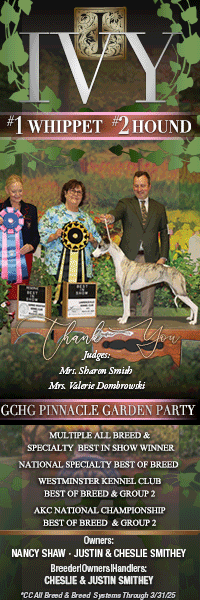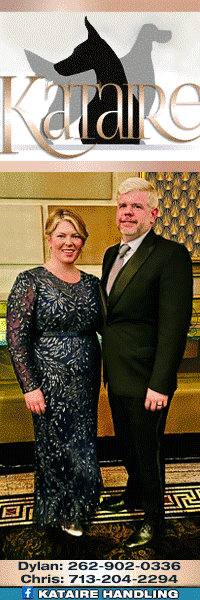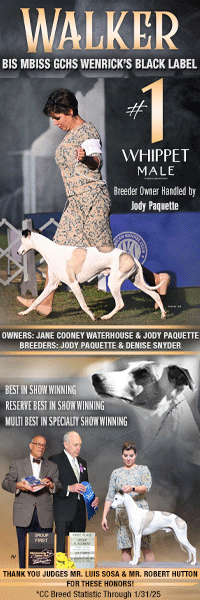The 7 Year Itch · Part 3
by Dr. Quentin N. La Ham
From the archives of The Canine Chronicle, June, 1992
PART 3
More often than not, judging involves trade-offs. This is the basis upon which respected judges interchange the same group of dogs because they rate factors differently in reaching a decision. That is as it should be and one only of several reasons, for example, why the Performance Evaluation Test (Hands-On) has been a failure and a waste of money, kept alive to whatever extent only in an attempt to save face. In my view, we do not have the right to judge solely on movement nor do we have the right to judge solely on heads or other obvious meristic characteristics. I will agree that the latter, in many cases, is more likely to happen. You can bet on it. I like a Sammy smile but I insist that he should be able to pull a sled! Bravo to those among us who recognize greatness in a dog while openly admitting that they would prefer a better head or darker eye, etc. These characteristics far easier to correct than, for example, to get and maintain a good front. It isn’t sufficient to pass a test on a breed standard as that only requires memorization–the important thing is to apply it. It is far better, in my opinion, to make an in-depth study of structure and movement as called for and/or should be known for the various basic breed types.
How far are we prepared to go with the preoccupation of our misconception of type? Do we distinguish between true types or do we help to create a fad or, at best, allow ourselves to “go with the flow” regardless of what the standard prescribes? Case in point: what has become common (almost to the extinction of what is correct) is to find Old English Sheepdogs higher in wither than at the croup. [Editor’s Note: this was written in 1992] That assures they will be more inclined to trot rather than amble, but is it right? This in spite of the fact that the Parent Club has written to those of us that judge them (I hope also to the breeders). Is this correct type? Is it right that contrary to what is explicitly stated in the standard of the Soft-Coated Wheaten concerning coat that it is commonplace and seemingly unquestioned that they are overgroomed and stylized? Is this the way we ascertain that they have correct coat type? Is it acceptable, just because in the last few years some individuals have trimmed Bouvier des Flandres to look like oversized Kerry Blue Terriers and have done some winning, that like so many sheep led to the slaughter great numbers are jumping on the bandwagon and judges tacitly approve? Is it correct type that so many Cairn Terriers and Corgis, in which the standard calls for medium or longer length of back, are losing to compact “types” contrary to the standard? In these same breeds, as well as in Dachshunds, is it “type”, contrary to the standard, to be breeding out the very characteristics inherent to achondroplastic breeds that helps them to overcome lateral displacement? AKC opened Pandora’s Box when they decided to standardize breed standards; so let’s rewrite the standard to fit your breed. Wasn’t that done in the first place, so why not make it a habit? Is it “type” to see so many German Shepherd Dogs stand and move as though they should be reclassified as Plantigrade?
“As they say in the field of medicine, it is far better to diagnose the problem before surgery is the only resort.”
Even when parent clubs go to the trouble to write to us as mentioned afore or as in the case of Golden Retrievers admonishing us as judges (and I hope breeders) about oversized or at best placing large dogs over the preferred size are we being true to type or are we laying a foundation that will produce undesirable, large dogs? Is it correct type to give the nod to a tell-tale serious structural fault occasionally seen in many breeds but far too common in very structurally incorrect Boxers and English Setters where we find dogs tracking so wide behind that it should be obvious that something is very wrong? The incidence of this problem is increasing. Surely we don’t need a Ph.D. in genetics to know something is being transmitted. I could give many other examples, but this I hope suffices.
The standard of a breed is, in part, open to interpretation but there are some absolutes that are not and they should not be passed over with the inexcusable excuse that we have to judge the whole dog. Of course we do but surely that means that when there are expressed size limits, as an example, and they are not met is this not a deviation from type? If the standard calls for the dog to be square and he is rectangular, isn’t this contrary to type? If the dog has a structural defect so serious that it’s likely introducing a serious genetic defect into the breed, isn’t this a violation against type? Are we so conditioned or uncaring that we ignore the fact that we have an inordinate number of “pigeon-toed” fronts and “sickle-hocked” rears that it is now of epidemic proportions. Is this good type?
Surely the necessary structure and inherent ability to endure in any type of working animal must be a major consideration in assessing a dog’s type. Albeit mankind has modified caninae to satisfy personal taste, but this need not be done at the expense of the raison d’etre of the breed.
In some persons minds I am labeled as a movement judge. I accept this compliment but over time it has been exaggerated and misinterpreted. I place much emphasis on movement and I wish more judges and breeders would do the same. It is easy to recognize when movement problems become blatantly obvious but it is far more difficult to diagnose as it insidiously comes creeping in. As they say in the field of medicine, it is far better to diagnose the problem before surgery is the only resort. It is not the easiest thing to do. Breeders and judges alike need to develop a far broader concept of type and they can only accomplish this through a clear, functional knowledge of structure and movement. Regrettable, since meristic type is not difficult to evaluate whereas correct structure and movement are; they suffer from a bias or, put another way, they often don’t get a fair shake. I have had more than one judge say to me, “if you can’t make up your mind as a last resort look at movement!” A shocking admission of ignorance.
As I travel about this country and others and address breeders, I usually challenge them about the quality of what they are producing as it relates to their standard. They respond vehemently that in order to win they have to breed what the judges are putting up even when they know it is contrary to the standard. If on the other hand one speaks with judges, we get the other side of the coin. “We have to judge what is brought in the ring.” So goes the circular argument.
I take the view that in the final analysis both share in the responsibility but, ultimately, the care, preservation and advancement of the breed (not to be confused with popularity) is the responsibility of the breeder. They must remain true to their breed and vigorously oppose the fads that appear in the guise of type.
Human nature being a fragile thing, is it any wonder that some judges lose sight of the fact that they are expected to judge the dogs on the day and not be intimidated by the dog’s paper trail of personalities or the various other sometimes less than ethical ways in which dogs are promoted. How else can one explain that a handler can change dogs in a breed and some among us put them up thinking it’s still the former “big winner”–apparently unable to make the distinction. Perhaps this is what is meant about judging the wrong end of the leash.
If you missed Part 1 and/or Part 2 of The 7 Year Itch click here
Short URL: https://caninechronicle.com/?p=183490
Comments are closed














